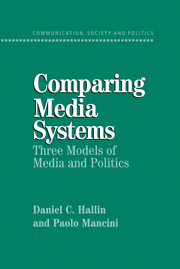9 - Conclusion
Published online by Cambridge University Press: 05 September 2012
Summary
At the beginning of this book we raised the question of whether stable connections could be identified between media systems and political systems. We believe we have shown that indeed, such connections can be identified. We have proposed a set of four principal dimensions for comparing media systems: the structure of media markets, including, particularly, the degree of development of the mass circulation press; the degree and form of political parallelism; the development of journalistic professionalism; and the degree and form of state intervention in the media system. And we have argued that there are important connections between the patterns of development of media systems, based on these dimensions, and certain key characteristics of the political system: the role of the state in society; the majoritarian or consensus character of the political system; the pattern of interest group organization, including the distinction between more fragmented liberal and more corporatist systems; the distinction between moderate and polarized pluralism; and the development of rational-legal authority in contrast to clientelist forms of social organization. A set of hypotheses about the connections between these variables is presented in Chapter 3 and we need not repeat them in detail here.
At times, political system characteristics are manifested more or less directly in media structures, as for example majoritarian or consensus patterns of government are reflected in the organization of public broadcasting institutions. Usually, however, the connections between media system and political system variables cannot be interpreted as a mechanistic, one-to-one correspondence.
- Type
- Chapter
- Information
- Comparing Media SystemsThree Models of Media and Politics, pp. 296 - 306Publisher: Cambridge University PressPrint publication year: 2004



